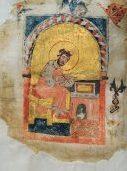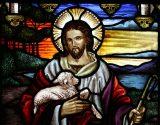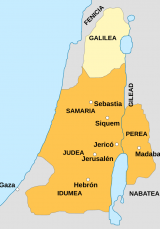Feeding the Five Thousand
30 The apostles gathered around Jesus, and told him all that they had done and taught. 31 He said to them, “Come away to a deserted place all by yourselves and rest a while.” For many were coming and going, and they had no leisure even to eat. 32 And they went away in the boat to a deserted place by themselves. 33 Now many saw them going and recognized them, and they hurried there on foot from all the towns and arrived ahead of them. 34 As he went ashore, he saw a great crowd; and he had compassion for them, because they were like sheep without a shepherd; and he began to teach them many things. 35 When it grew late, his disciples came to him and said, “This is a deserted place, and the hour is now very late; 36 send them away so that they may go into the surrounding country and villages and buy something for themselves to eat.” 37 But he answered them, “You give them something to eat.” They said to him, “Are we to go and buy two hundred denarii[a] worth of bread, and give it to them to eat?” 38 And he said to them, “How many loaves have you? Go and see.” When they had found out, they said, “Five, and two fish.” 39 Then he ordered them to get all the people to sit down in groups on the green grass. 40 So they sat down in groups of hundreds and of fifties. 41 Taking the five loaves and the two fish, he looked up to heaven, and blessed and broke the loaves, and gave them to his disciples to set before the people; and he divided the two fish among them all. 42 And all ate and were filled; 43 and they took up twelve baskets full of broken pieces and of the fish. 44 Those who had eaten the loaves numbered five thousand men.
Feeding the Four Thousand
8 In those days when there was again a great crowd without anything to eat, he called his disciples and said to them, 2 “I have compassion for the crowd, because they have been with me now for three days and have nothing to eat. 3 If I send them away hungry to their homes, they will faint on the way—and some of them have come from a great distance.” 4 His disciples replied, “How can one feed these people with bread here in the desert?” 5 He asked them, “How many loaves do you have?” They said, “Seven.” 6 Then he ordered the crowd to sit down on the ground; and he took the seven loaves, and after giving thanks he broke them and gave them to his disciples to distribute; and they distributed them to the crowd. 7 They had also a few small fish; and after blessing them, he ordered that these too should be distributed. 8 They ate and were filled; and they took up the broken pieces left over, seven baskets full. 9 Now there were about four thousand people. And he sent them away. 10 And immediately he got into the boat with his disciples and went to the district of Dalmanutha.
What to do with this educator’s commentary
This commentary invites you as a teacher to engage with and interpret the passage. Allow the text to speak first. The commentary suggests that you ask yourself various questions that will aid your interpretation. They will help you answer for yourself the question in the last words of the text: ‘what does this mean?’
This educator’s commentary is not a ‘finished package’. It is for your engagement with the text. You then go on to plan how you enable your students to work with the text.
Both you and your students are the agents of interpretation. The ‘Worlds of the Text’ offer a structure, a conversation between the worlds of the author and the setting of the text; the world of the text; and the world of reader. In your personal reflection and in your teaching all three worlds should be integrated as they rely on each other.
In your teaching you are encouraged to ask your students to engage with the text in a dialogical way, to explore and interpret it, to share their own interpretation and to listen to that of others before they engage with the way the text might relate to a topic or unit of work being studied.
Structure of the commentary:
The world of the author’s community
The world at the time of the text
Geography of the text
Questions for the teacher
Text & textual features
Characters & setting
Ideas / phrases / concepts
Questions for the teacher
The world in front of the text
Questions for the teacher
Meaning for today / challenges
Church interpretations & usage
The World Behind the Text
See general introduction to Mark.
The world of the text
Text & textual features

Mark’s gospel is written in the style of a narrative but not necessarily from a literal perspective. The gap of some 40 years between the event Mark writes about and his writing for his own community, some distance from the setting of the Gospel, shifts his perspective from the details of what happened, to what it might mean that it happened.
The feeding of the 5000 and the Feeding of the 4000 are both miracle stories within the Gospel narrative. Miracle stories have a predictable structure and are used in the bible to demonstrate God’s compassion and protective love. They serve to show the divinity of Jesus; that he is filled with the Holy Spirit, the incarnation of God – one who does not pray for miracles but is able to bring them about himself.
Two accounts – Two events? Most scholars think that the repetition of this event by Mark is for literary purposes not a reflection of its occurrence twice in the lifetime of Jesus. The story of the feeding of the 5000 was clearly important to the early Christian communities as it is one of a few stories which is present in all four Gospels and the feeding of 4000 is present in both Mark and Matthew. In reading these narratives we must consider why Mark felt it important to include both accounts for his audience.
It is suggested that the writer of the scriptures is using a Jewish literary technique which interprets an event by relating it to a previous historical event. In this case, Mark claims that Jesus performed a similar act to that found in a story from Hebrew scriptures where Moses fed the people with bread from heaven. Mark seems to want to indicate to the reader that Jesus is as great or greater than Moses. The passages are also reminiscent of Elijah feeding the widow of Zarepath (1Kings 17:8-16) and Elisha feeding the people (2 Kings 4:42-44).

The Good Shepherd motif, in which God appears as the shepherd tending for their sheep, which appears in the feeding of the 5000 is also widely used in Hebrew scriptures and in each case describes the suffering of the people due to lack of leadership (Num 27:17; 1Kings 22:17; Jdt 11:19; Ezek 34:8; Zech 10:2).
Whatever their origin, these narratives are very well crafted and had probably been told often.
Characters & setting
Prior to exploring the passages in detail, focus on the basics: setting, events, characters. How are the narratives the same; how are they different? These two feeding stories are similar but not the same. The central figure in both stories is Jesus.
The key difference is subtle but crucial: the setting. The feeding of the 5000 takes place on Jewish territory. The crowd in this first story is Jewish. The setting is a secluded place which Jesus and the disciples reach by boat in order to have some rest. The fact that the crowd make it to the secluded place ahead of the boat signifies the enthusiasm of the crowd for Jesus. Although the story speaks of 5000 men it is likely that the crowds in both stories consisted of men, women and children.

The setting of the second story is gentile territory probably the Decapolis region and the crowds are gentiles. In this story the enthusiasm of the crowds is indicated by the fact that they have been following Jesus for three days.
Mark’s community would have included both Jews and Gentiles; by situating this event in land symbolic of them, he is able to indicate that Jesus feeds all: Jew and Gentile.
The other characters in the story are the apostles who have just returned from a successful mission in the villages.
Ideas/phrases/concepts
The geographical location links to the phrase Mark uses to describe the people who have gathered. Both stories highlight Jesus’ compassion for the crowds: in the Feeding the 5000, in Jewish territory, Jesus feels compassion for the people because “they were like sheep without a shepherd”. For the gentiles, in Feeding the 4000 Jesus’ compassion was due to their being hungry after travelling long distances and being with Jesus for three days. The symbolic invitation could signify their hunger for what they have not known.
In both, both Jews and the Gentiles receive spiritual nourishment through an inspiring talk and ultimately a divine feeding.
The Jewish crowd learnt by Jesus’ action in feeding them that God was a God who cared. The image of God as the good shepherd is further reinforced by the crowds being invited to sit on the green grass as described in psalm 23 where “he makes me lie down in green pastures”.
The reaction of the disciples in both stories continues Mark’s sense that the disciples were confused and somewhat at a loss. It demonstrates that they are still learning about Jesus’ ways which provides an opportunity for Jesus to also teach the reader. These stories help the disciples know that it is not they who heal and feed and teach but God.
In both of these stories the disciples are challenged to step outside their traditional roles and to trust Jesus as he calls them to service.
In these stories Mark uses the same four verbs he will use for the institution of the Eucharist – take, bless break and give. Mark’s use of the same language for Eucharist as the feeding of thousands points to the importance of Eucharist to the formation of Christian communities.
The actions of Jesus reflect liturgy and in each story the language is suited to the audience, “blessing and praising” for the Jewish audience and “giving thanks” for the gentile audience. After feeding the crowds 12 baskets of scraps were left over. This indicates completeness or plenty and highlights the generosity of God and demonstrates what God’s kingdom will be like. In the second story it is thought that 7 is the number which indicates completeness in the gentile world.
The feeding of the 4000, coming after the challenge of the Syrophoenician woman that the dogs can eat the children’s scraps under the table, is reinforcing the idea that Jesus has come for all people.
It is likely that these stories have grown out of many memories of Jesus compassion, care, kindness, smiles, which touched people’s hearts and fed their deepest hungers.
The narratives teach that God is the source of hope and nourishment for all people.
The inclusion of the event twice provides a complete image of Jesus as the shepherd king of Israel and the inclusion of all nations of the world in God’s kingdom.
Questions for the teacher:
The world in front of the text
Questions for the teacher:
Please reflect on these questions before reading this section and then use the material below to enrich your responsiveness to the text.
Meaning for today/challenges
For Mark, Jesus’ miracles indicated that he was the Messiah; the anointed of God. We are invited to accept that, but to seek a deeper figurative meaning as well. Leaving the narratives at a literal level leaves much richness untapped.
- The word of God is nourishment for our lives.
- God’s generosity is immense
- God’s ways are not always easily understood by us.
- Jesus is the bread of life. The Eucharist provides us with an opportunity to receive nourishment.
- Celebration of the Eucharist and the sharing of Christ is essential for community.
- God is our source of hope
- Our acts of service with Christ can bring nourishment to a hungry world
- Jesus who was with the disciples then is with us now
- Jesus intervention was not just organisational but miraculous and symbolic.
Church interpretation & usage
The Church usually simply accepts the miraculous nature of the passages, so there isno specific description of how Jesus multiplied the loaves and fish. Some, trying to ‘make the miracle work’ suggest that the modelling of Jesus prompted others to share what they had, or that the crowd were very happy to take only a very little. We can be better employed remembering Mark’s intention and focusing on trying to find meaning beyond the surface, rather than trying to make the passages a literal report or description.
Liturgical usage
Mark’s feeding stories are omitted from the Sunday readings but are used on some weekdays.
John’s version of the feeding story is used for the Sunday liturgy 17th Sunday in Ordinary time year B.
